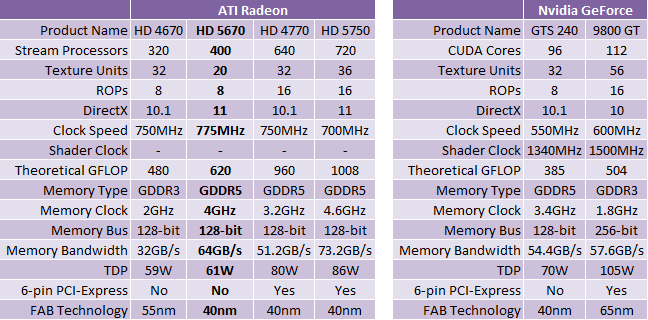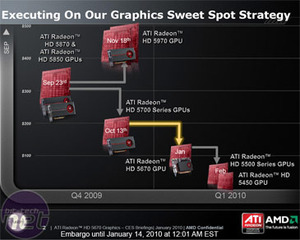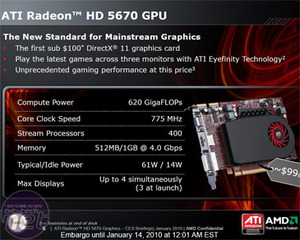
AMD ATI Radeon HD 5670 Review
Manufacturer: AMD512MB Model:
UK Price (as reviewed): £73.32 (inc. VAT)US Price (as reviewed): TBC
1GB Model:
UK Price (as reviewed): £91.63 (inc. VAT)US Price (as reviewed): TBC
AMD has been sitting pretty for the last four months atop its exclusive support of DirectX 11 and with titles supporting the new standard, such as Dirt 2 and next month’s Aliens vs. Predator, customers are being increasingly coaxed to hand over their cash for a tasty slice of red-flavoured silicon.
With Nvidia’s first Fermi products still at least a month away from our test benches, ATI has the luxury of total domination of the DirectX 11 market and has an increasingly growing family of cards based around its initial Cypress GPU architecture.
However, while most hardware enthusiasts will feel well catered for when it comes to DX11 thanks to cards such as the Radeons HD 5870, HD 5850 and HD 5770 (when they’re in stock) or even the HD 5750, the reality is that the biggest market when it comes to graphics cards is customers spending less than £80 ($100). This is where ATI’s latest addition, the Radeon HD 5670, comes in; a low cost DX11 card that, perhaps most importantly considering its mass market audience, does not require an external power connector.
Of course, dropping an external power connector and targeting a lower price point mean that there have had to be some significant cuts when it comes to the core hardware involved. The 40nm GPU, codenamed Redwood (to the 57xx series’ Juniper and the 58xx series’ Cypress) sports a lowly 400 stream processors running at 775MHz (in comparison to the HD 5770’s 800 and the HD 5870’s1,600 stream processors, running at 725MHz and 850MHz respectively), with those 400 comprising just twenty texture units.
The number of ROPs has also been halved from the HD 5750, from 16 down to eight, resulting in a card that is a notable step down in GPU performance, at least on paper, even from the fairly low-performance HD 5750. However, AMD has at least chosen to furnish the HD 5670 with a 128-bit memory bus – the same as the HD 57xx series - and furnished the card with GDDR5 memory in either 512MB or 1GB configurations (most cards at launch will use 1GB), with the memory running at 1GHz (4GHz effective).
All these hardware cuts have come with the benefit of much lower power demands though, allowing the HD 5670 to tip the scales at a miserly 61W typical maximum board power, and an excellent idle power draw of just 14W. This low power consumption has allowed ATI to do away with any kind of additional power connector, crucial for the low-end upgrade market where manufactures want to simplify the installation procedure as much as possible.

MSI MPG Velox 100R Chassis Review
October 14 2021 | 15:04















Want to comment? Please log in.